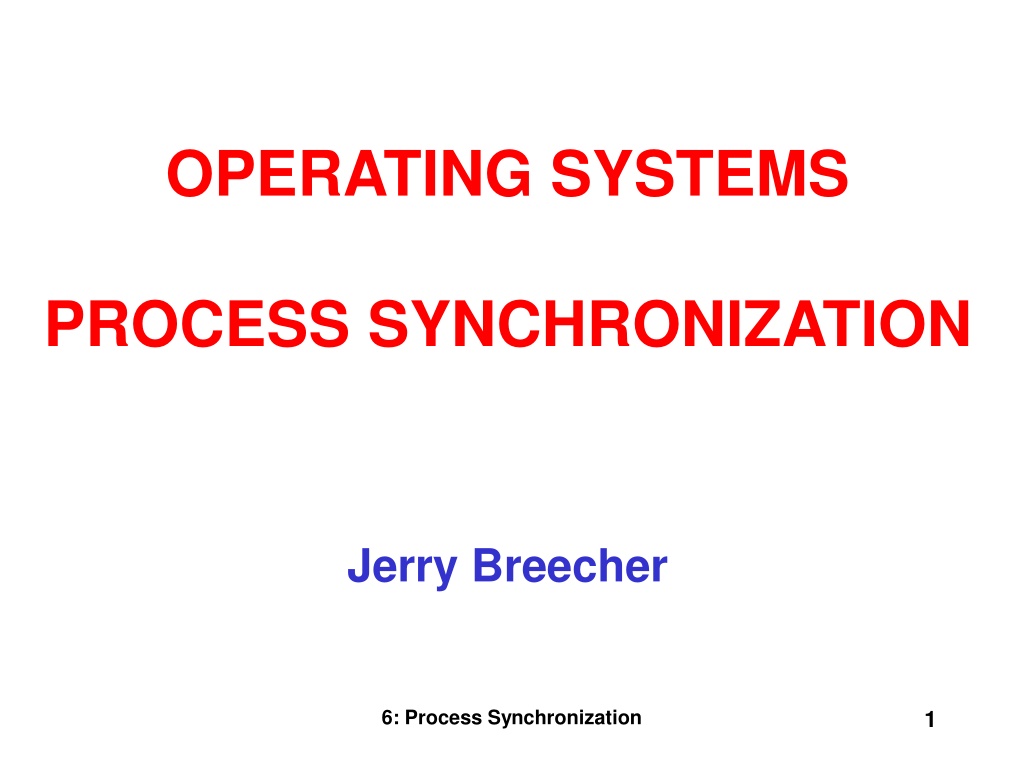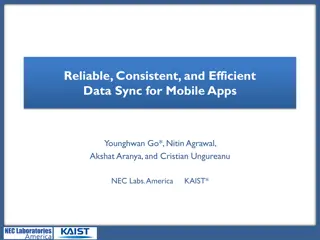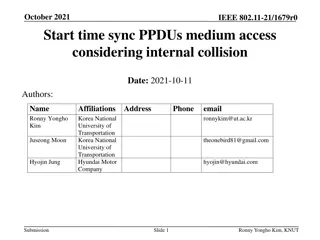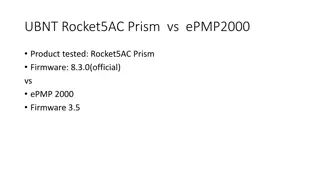
Process Synchronization in Operating Systems
Learn about process synchronization in operating systems, including coordinating processes, resource sharing, acquiring locks, and real-world examples. Explore topics like the critical-section problem, hardware synchronization, semaphores, and classic synchronization issues. Dive into the Producer-Consumer problem with code segments and understand the complexities of synchronization.
Download Presentation

Please find below an Image/Link to download the presentation.
The content on the website is provided AS IS for your information and personal use only. It may not be sold, licensed, or shared on other websites without obtaining consent from the author. If you encounter any issues during the download, it is possible that the publisher has removed the file from their server.
You are allowed to download the files provided on this website for personal or commercial use, subject to the condition that they are used lawfully. All files are the property of their respective owners.
The content on the website is provided AS IS for your information and personal use only. It may not be sold, licensed, or shared on other websites without obtaining consent from the author.
E N D
Presentation Transcript
OPERATING SYSTEMS PROCESS SYNCHRONIZATION Jerry Breecher 6: Process Synchronization 1
OPERATING SYSTEM Synchronization What Is In This Chapter? This is about getting processes to coordinate with each other. How do processes work with resources that must be shared between them? How do we go about acquiring locks to protect regions of memory? How is synchronization really used? 6: Process Synchronization 2
OPERATING SYSTEM Synchronization Topics Covered Background The Critical-Section Problem Peterson s Solution Synchronization Hardware Semaphores Classic Problems of Synchronization Synchronization Examples Atomic Transactions 6: Process Synchronization 3
The Producer Consumer Problem PROCESS SYNCHRONIZATION A producer process "produces" information "consumed" by a consumer process. Here are the variables needed to define the problem: #define BUFFER_SIZE 10 typedef struct { DATA } item; item buffer[BUFFER_SIZE]; int in = 0; int out = 0; int counter = 0; // Number of buffers currently full data; // Location of next input to buffer // Location of next removal from buffer Consider the code segments on the next page: Does it work? Are all buffers utilized? 6: Process Synchronization 4
The Producer Consumer Problem #define BUFFER_SIZE 10 typedef struct { DATA } item; item buffer[BUFFER_SIZE]; int in = 0; int out = 0; int counter = 0; PROCESS SYNCHRONIZATION A producer process "produces" information "consumed" by a consumer process. data; item nextProduced; PRODUCER while (TRUE) { while (counter == BUFFER_SIZE); buffer[in] = nextProduced; in = (in + 1) % BUFFER_SIZE; counter++; } item nextConsumed; CONSUMER while (TRUE) { while (counter == 0); nextConsumed = buffer[out]; out = (out + 1) % BUFFER_SIZE; counter--; } producer consumer 6: Process Synchronization 5
The Producer Consumer Problem PROCESS SYNCHRONIZATION Note that counter++; this line is NOT what it seems!! is really --> register = counter register = register + 1 counter = register At a micro level, the following scenario could occur using this code: TO; T1; T2; T3; T4; T5; Producer Producer Consumer Consumer Producer Consumer Execute register1 = counter Execute register1 = register1 + 1 Execute register2 = counter Execute register2 = register2 - 1 Execute counter = register1 Execute counter = register2 register1 = 5 register1 = 6 register2 = 5 register2 = 4 counter = 6 counter = 4 6: Process Synchronization 6
//////////////////////////////////////////////////////////////////////////////////////////////////////////////////////////////////////////////////// // Adder - code executed by one of the threads ////////////////////////////////////////////////////////////////////////// void *Adder(void *arg) { int i; for (i = 0; i < LoopCount; i++) { GlobalVariable++; } // End of for } // End of Adder .globl Adder .type Adder, @function Adder: pushq %rbp movq %rsp, %rbp movq %rdi, -8(%rbp) movl $0, -12(%rbp) .L10: movl -12(%rbp), %eax cmpl LoopCount(%rip), %eax jl .L13 jmp .L11 .L13: incl GlobalVariable(%rip) leaq -12(%rbp), %rax incl (%rax) jmp .L10 .L11: leave ret .gcc ThreadsRunAmock.c -S So why does ThreadsRunAmock.c give such strange behavior on a multiprocessor?? 6: Process Synchronization 7
Intel Architecture Software Developer's Manual, Volume 2: Instruction Set Reference Manual This instruction is NOT atomic!! 6: Process Synchronization 8
PROCESS SYNCHRONIZATION Critical Sections A section of code, common to n cooperating processes, in which the processes may be accessing common variables. A Critical Section Environment contains: Entry Section Code requesting entry into the critical section. Critical Section Code in which only one process can execute at any one time. Exit Section The end of the critical section, releasing or allowing others in. Remainder Section Rest of the code AFTER the critical section. 6: Process Synchronization 9
PROCESS SYNCHRONIZATION Critical Sections The critical section must ENFORCE ALL THREE of the following rules: Mutual Exclusion: No more than one process can execute in its critical section at one time. Progress: If no one is in the critical section and someone wants in, then those processes not in their remainder section must be able to decide in a finite time who should go in. Bounded Wait: All requesters must eventually be let into the critical section. 6: Process Synchronization 10
PROCESS SYNCHRONIZATION Two Processes Software Here s an example of a simple piece of code containing the components required in a critical section. do { } while(TRUE); Entry Section while ( turn ^= i ); /* critical section */ turn = j; /* remainder section */ Critical Section Exit Section Remainder Section 6: Process Synchronization 11
PROCESS SYNCHRONIZATION Two Processes Software Here we try a succession of increasingly complicated solutions to the problem of creating valid entry sections. NOTE: In all examples, i is the current process, j the "other" process. In these examples, envision the same code running on two processors at the same time. TOGGLED ACCESS: Are the three Critical Section Requirements Met? Algorithm 1 The critical section must ENFORCE ALL THREE of the following rules: do { } while(TRUE); while ( turn ^= i ); /* critical section */ turn = j; /* remainder section */ Mutual Exclusion: No more than one process can execute in its critical section at one time. Progress: If no one is in the critical section and someone wants in, then those processes not in their remainder section must be able to decide in a finite time who should go in. Bounded Wait: All requesters must eventually be let into the critical section. 6: Process Synchronization 12
PROCESS SYNCHRONIZATION Two Processes Software FLAG FOR EACH PROCESS GIVES STATE: Each process maintains a flag indicating that it wants to get into the critical section. It checks the flag of the other process and doesn t enter the critical section if that other process wants to get in. Shared variables boolean flag[2]; flag [i] = true Pi ready to enter its critical section Algorithm 2 initially flag [0] = flag [1] = false. Are the three Critical Section Requirements Met? The critical section must ENFORCE ALL THREE of the following rules: do { } while (1); Mutual Exclusion: No more than one process can execute in its critical section at one time. flag[i] := true; while (flag[j]) ; critical section flag [i] = false; remainder section Progress: If no one is in the critical section and someone wants in, then those processes not in their remainder section must be able to decide in a finite time who should go in. Bounded Wait: All requesters must eventually be let into the critical section. 6: Process Synchronization 13
PROCESS SYNCHRONIZATION Two Processes Software FLAG TO REQUEST ENTRY: Each processes sets a flag to request entry. Then each process toggles a bit to allow the other in first. This code is executed for each process i. This is Peterson s Solution Algorithm 3 Shared variables boolean flag[2]; flag [i] = true Pi ready to enter its critical section initially flag [0] = flag [1] = false. Are the three Critical Section Requirements Met? Mutual Exclusion: No more than one process can execute in its critical section at one time. do { } while (1); flag [i]:= true; turn = j; while (flag [j] and turn == j) ; critical section flag [i] = false; remainder section Progress: If no one is in the critical section and someone wants in, then those processes not in their remainder section must be able to decide in a finite time who should go in. Bounded Wait: All requesters must eventually be let into the critical section. 6: Process Synchronization 14
PROCESS SYNCHRONIZATION Analysis of Peterson Solution CASE 1: i j flag [i]:= true; turn = j; while (flag [j] and turn == j) ; Result?? CASE 2: This thread doesn t run i j flag [i]:= true; flag [j]:= true; turn = i; turn = j; while (flag [j] and turn == j) ; Result?? while (flag [i] and turn == i) ; Result??
PROCESS SYNCHRONIZATION Analysis of Peterson Solution CASE 3: i j flag [i]:= true; turn = j; flag [j]:= true; turn = i; while (flag [i] and turn == i) ; Result?? while (flag [j] and turn == j) ; Result?? CASE 4: i j flag [i]:= true; flag [j]:= true; turn = j; turn = i; while (flag [i] and turn == i) ; Result?? while (flag [j] and turn == j) ; Result??
PROCESS SYNCHRONIZATION So, What Happened? We examined the Peterson algorithm it looked good. We ran the code for the Peterson Solution. It worked for small iterations, but for a large number of iterations it failed. The algorithm is good, the hardware is bad . Or more accurately, our model of the hardware is not correct. What s going on? We are evaluating while (flag [j] and turn == j) ; Here s the code as generated on Windows with the complier command: gcc ThreadsPeterson.c -S o ThreadsPeterson.s // L14: // movl -4(%ebp), %eax // movl _flag(,%eax,4), %eax // testl %eax, %eax // je L12 // movl _turn, %eax // cmpl -4(%ebp), %eax // je L14 //L12: leave ret Here we evaluate first flag, and then turn.. Everything is great as long as flag and turn are consistent with each other. What if only one of the variables has been modified as seen by the executing thread? 6: Process Synchronization 17
PROCESS SYNCHRONIZATION MFENCE The Intel instruction MFENCE performs a serializing operation on all load and store instructions that were issued prior the MFENCE instruction. This serializing operation guarantees that every load and store instruction that precedes in program order the MFENCE instruction is globally visible before any load or store instruction that follows the MFENCE instruction is globally visible. The MFENCE instruction is ordered with respect to all load and store instructions, other MFENCE instructions, any SFENCE and LFENCE instructions, and any serializing instructions (such as the CPUID instruction). Weakly ordered memory types can enable higher performance through such techniques as out-of-order issue, speculative reads, write-combining, and write-collapsing. The degree to which a consumer of data recognizes or knows that the data is weakly ordered varies among applications and may be unknown to the producer of this data. The MFENCE instruction provides a performance-efficient way of ensuring ordering between routines that produce weakly-ordered results and routines that consume this data. It should be noted that processors are free to speculatively fetch and cache data from system memory regions that are assigned a memory-type that permits speculative reads (that is, the WB, WC, and WT memory types). The PREFETCHh instruction is considered a hint to this speculative behavior. Because this speculative fetching can occur at any time and is not tied to instruction execution, the MFENCE instruction is not ordered with respect to PREFETCHh or any of the speculative fetching mechanisms (that is, data could be speculative loaded into the cache just before, during, or after the execution of an MFENCE instruction). Operation Wait_On_Following_Loads_And_Stores_Until(preceding_loads_and_stores_globally_visible); 6: Process Synchronization 18
Code for Petersons Algorithm ////////////////////////////////////////////////////////////////////////// // Here's how the compiler generates code for the while line and how we ve // added a synchronizing statement. // // L14: // mfence Line Added // movl -4(%ebp), %eax // movl _flag(,%eax,4), %eax // testl %eax, %eax // je L12 // movl _turn, %eax // cmpl -4(%ebp), %eax // je L14 //L12: leave ret // ////////////////////////////////////////////////////////////////////////// 6: Process Synchronization 19
Code for Petersons Algorithm Here s the total operation we perform here: gcc ThreadsPeterson.c o ThreadsPeterson // We find this fails gcc ThreadsPeterson.c S o ThreadsPetersonNoFence.s gcc ThreadsPeterson.c S o ThreadsPetersonFence.s // We modify the Fence assembly code to add the mfence instruction gcc ThreadsPetersonNoFence.s o ThreadsPetersonNoFence gcc ThreadsPetersonFence.s o ThreadsPetersonFence // Execute both programs 6: Process Synchronization 20
PROCESS SYNCHRONIZATION Critical Sections The hardware required to support critical sections must have (minimally): Indivisible instructions (what are they?) Atomic load, store, test instruction. For instance, if a store and test occur simultaneously, the test gets EITHER the old or the new, but not some combination. Two atomic instructions, if executed simultaneously, behave as if executed sequentially. 6: Process Synchronization 21
PROCESS SYNCHRONIZATION Hardware Solutions Disabling Interrupts: Works for the Uni Processor case only. WHY? Atomic test and set: Returns parameter and sets parameter to true atomically. while ( test_and_set ( lock ) ); /* critical section */ lock = false; Example of Assembler code: GET_LOCK: IF_CLEAR_THEN_SET_BIT_AND_SKIP <bit_address> BRANCH GET_LOCK ------- /* set failed */ /* set succeeded */ Must be careful if these approaches are to satisfy a bounded wait condition - must use round robin - requires code built around the lock instructions. 6: Process Synchronization 22
PROCESS SYNCHRONIZATION Hardware Solutions // Note: On entry, edx register contains address of lock variable Loop: // move 1 into eax register mov eax, 1 // xchg 1 with value contained in the lock variable lock xchg DWORD PTR[edx], eax // After the xchg, there are two possible conditions: // If lock was originally =1 (locked) , after xchg lock = 1, eax = 1 // If lock was originally =0 (unlocked), after xchg lock = 1, eax = 0 // if eax is not zero, it means the lock was already held so try again test eax, eax jne Loop Using Intel xchg instruction // We now hold the lock 6: Process Synchronization 23
PROCESS SYNCHRONIZATION Hardware Solutions Boolean int Boolean do { } while (TRUE); waiting[N]; j; key; /* Takes on values from 0 to N - 1 */ waiting[i] = TRUE; key = TRUE; while( waiting[i] && key ) key = test_and_set( lock ); /* Spin lock waiting[ i ] = FALSE; /****** CRITICAL SECTION ********/ j = ( i + 1 ) mod N; while ( ( j != i ) && ( ! waiting[ j ] ) ) j = ( j + 1 ) % N; if ( j == i ) lock = FALSE; else waiting[ j ] = FALSE; /******* REMAINDER SECTION *******/ */ Using Hardware Test_and_set. 6: Process Synchronization 24
PROCESS SYNCHRONIZATION Current Hardware Dilemmas We first need to define, for multiprocessors: caches, shared memory (for storage of lock variables), write through cache, write pipes. The last software solution we did ( the one we thought was correct ) may not work on a cached multiprocessor. Why? { Hint, is the write by one processor visible immediately to all other processors?} What changes must be made to the hardware for this program to work? 6: Process Synchronization 25
PROCESS SYNCHRONIZATION Current Hardware Dilemmas Does the sequence below work on a cached multiprocessor? Initially, location a contains A0 and location b contains B0. a) Processor 1 writes data A1 to location a. b) Processor 1 sets b to B1 indicating data at a is valid. c) Processor 2 waits for b to take on value B1 and loops until that change occurs. d) Processor 2 reads the value from a. What value is seen by Processor 2 when it reads a? How must hardware be specified to guarantee the value seen? a: A0 b: B0 6: Process Synchronization 26
PROCESS SYNCHRONIZATION Current Hardware Dilemmas We need to discuss: Write Ordering: The first write by a processor will be visible before the second write is visible. This requires a write through cache. Sequential Consistency: If Processor 1 writes to Location a "before" Processor 2 writes to Location b, then a is visible to ALL processors before b is. To do this requires NOT caching shared data. The software solutions discussed earlier should be avoided since they require write ordering and/or sequential consistency. 6: Process Synchronization 27
PROCESS SYNCHRONIZATION Current Hardware Dilemmas Hardware test and set on a multiprocessor causes an explicit flush of the write to main memory and the update of all other processor's caches. Imagine needing to write all shared data straight through the cache. With test and set, only lock locations are written out explicitly. In not too many years, hardware will no longer support software solutions because of the performance impact of doing so. 6: Process Synchronization 28
PROCESS SYNCHRONIZATION Semaphores PURPOSE: We want to be able to write more complex constructs and so need a language to do so. We thus define semaphores which we assume are atomic operations: WAIT ( S ): while ( S <= 0 ); S = S - 1; SIGNAL ( S ): S = S + 1; As given here, these are not atomic as written in "macro code". We define these operations, however, to be atomic (Protected by a hardware lock.) FORMAT: <-- Mutual exclusion: mutex init to 1. wait ( mutex ); CRITICAL SECTION signal( mutex ); REMAINDER 6: Process Synchronization 29
PROCESS SYNCHRONIZATION Semaphores Semaphores can be used to force synchronization ( precedence ) if the preceeder does a signal at the end, and the follower does wait at beginning. For example, here we want P1 to execute before P2. P1: statement 1; signal ( synch ); P2: wait ( synch ); statement 2; 6: Process Synchronization 30
PROCESS SYNCHRONIZATION Semaphores We don't want to loop on busy, so will suspend instead: Block on semaphore == False, Wakeup on signal ( semaphore becomes True), There may be numerous processes waiting for the semaphore, so keep a list of blocked processes, Wakeup one of the blocked processes upon getting a signal ( choice of who depends on strategy ). To PREVENT looping, we redefine the semaphore structure as: typedef struct { int struct process } SEMAPHORE; value; *list; /* linked list of PTBL waiting on S */ 6: Process Synchronization 31
PROCESS SYNCHRONIZATION Semaphores typedef struct { int struct process *list; /* linked list of PTBL waiting on S */ } SEMAPHORE; value; SEMAPHORE s; wait(s) { s.value = s.value - 1; if ( s.value < 0 ) { add this process to s.L; block; } } SEMAPHORE s; signal(s) { s.value = s.value + 1; if ( s.value <= 0 ) { remove a process P from s.L; wakeup(P); } } It's critical that these be atomic - in uniprocessors we can disable interrupts, but in multiprocessors other mechanisms for atomicity are needed. Popular incarnations of semaphores are as "event counts" and "lock managers". (We'll talk about these in the next chapter.) 6: Process Synchronization 32
PROCESS SYNCHRONIZATION Semaphores DEADLOCKS: May occur when two or more processes try to get the same multiple resources at the same time. P1: wait(S); wait(Q); ..... signal(S); signal(Q); ..... P2: wait(Q); wait(S); signal(Q); signal(S); How can this be fixed? 6: Process Synchronization 33
PROCESS SYNCHRONIZATION Railways in the Andes; A Practical Problem High in the Andes mountains, there are two circular railway lines. One line is in Peru, the other in Bolivia. They share a common section of track where the lines cross a mountain pass that lies on the international border (near Lake Titicaca?). Unfortunately, the Peruvian and Bolivian trains occasionally collide when simultaneously entering the common section of track (the mountain pass). The trouble is, alas, that the drivers of the two trains are both blind and deaf, so they can neither see nor hear each other. 6: Process Synchronization 34
The two drivers agreed on the following method of preventing collisions. They set up a large bowl at the entrance to the pass. Before entering the pass, a driver must stop his train, walk over to the bowl, and reach into it to see it it contains a rock. If the bowl is empty, the driver finds a rock and drops it in the bowl, indicating that his train is entering the pass; once his train has cleared the pass, he must walk back to the bowl and remove his rock, indicating that the pass in no longer being used. Finally, he walks back to the train and continues down the line. If a driver arriving at the pass finds a rock in the bowl, he leaves the rock there; he repeatedly takes a siesta and rechecks the bowl until he finds it empty. Then he drops a rock in the bowl and drives his train into the pass. A smart graduate from the University of La Paz (Bolivia) claimed that subversive train schedules made up by Peruvian officials could block the train forever. Explain The Bolivian driver just laughed and said that could not be true because it never happened. Explain Unfortunately, one day the two trains crashed. Explain 6: Process Synchronization 35
Following the crash, the graduate was called in as a consultant to ensure that no more crashes would occur. He explained that the bowl was being used in the wrong way. The Bolivian driver must wait at the entry to the pass until the bowl is empty, drive through the pass and walk back to put a rock in the bowl. The Peruvian driver must wait at the entry until the bowl contains a rock, drive through the pass and walk back to remove the rock from the bowl. Sure enough, his method prevented crashes. Prior to this arrangement, the Peruvian train ran twice a day and the Bolivian train ran once a day. The Peruvians were very unhappy with the new arrangement. Explain The graduate was called in again and was told to prevent crashes while avoiding the problem of his previous method. He suggested that two bowls be used, one for each driver. When a driver reaches the entry, he first drops a rock in his bowl, then checks the other bowl to see if it is empty. If so, he drives his train through the pass. Stops and walks back to remove his rock. But if he finds a rock in the other bowl, he goes back to his bowl and removes his rock. Then he takes a siesta, again drops a rock in his bowl and re-checks the other bowl, and so on, until he finds the other bowl empty. This method worked fine until late in May, when the two trains were simultaneously blocked at the entry for many siestas. Explain 6: Process Synchronization 36
PROCESS SYNCHRONIZATION Some Interesting Problems THE BOUNDED BUFFER ( PRODUCER / CONSUMER ) PROBLEM: This is the same producer / consumer problem as before. But now we'll do it with signals and waits. Remember: a wait decreases its argument and a signal increases its argument. BINARY_SEMAPHORE COUNTING_SEMAPHORE mutex = 1; empty = n; full = 0; // Can only be 0 or 1 // Can take on any integer value producer: do { /* produce an item in nextp */ wait (empty); /* Do action */ wait (mutex); /* Buffer guard*/ /* add nextp to buffer */ signal (mutex); signal (full); } while(TRUE); consumer: do { wait (full); wait (mutex); /* remove an item from buffer to nextc */ signal (mutex); signal (empty); /* consume an item in nextc */ } while(TRUE); 6: Process Synchronization 37
PROCESS SYNCHRONIZATION Some Interesting Problems THE READERS/WRITERS PROBLEM: This is the same as the Producer / Consumer problem except - we now can have many concurrent readers and one exclusive writer. Locks: are shared (for the readers) and exclusive (for the writer). Two possible ( contradictory ) guidelines can be used: No reader is kept waiting unless a writer holds the lock (the readers have precedence). If a writer is waiting for access, no new reader gains access (writer has precedence). ( NOTE: starvation can occur on either of these rules if they are followed rigorously.) 6: Process Synchronization 38
PROCESS SYNCHRONIZATION Some Interesting Problems Writer: do { wait( wrt ); /* writing is performed */ signal( wrt ); } while(TRUE); THE READERS/WRITERS PROBLEM: BINARY_SEMAPHORE wrt = 1; BINARY_SEMAPHORE mutex = 1; int readcount = 0; Reader: do { wait( mutex ); readcount = readcount + 1; if readcount == 1 then wait(wrt ); /* 1st reader locks writer */ signal( mutex ); /* reading is performed */ wait( mutex ); readcount = readcount - 1; if readcount == 0 then signal(wrt ); /*last reader frees writer */ signal( mutex ); } while(TRUE); WAIT ( S ): while ( S <= 0 ); S = S - 1; SIGNAL ( S ): S = S + 1; /* Allow 1 reader in entry*/ 6: Process Synchronization 39
PROCESS SYNCHRONIZATION Some Interesting Problems THE DINING PHILOSOPHERS PROBLEM: 5 philosophers with 5 chopsticks sit around a circular table. They each want to eat at random times and must pick up the chopsticks on their right and on their left. Clearly deadlock is rampant ( and starvation possible.) Several solutions are possible: Allow only 4 philosophers to be hungry at a time. Allow pickup only if both chopsticks are available. ( Done in critical section ) Odd # philosopher always picks up left chopstick 1st, even # philosopher always picks up right chopstick 1st. 6: Process Synchronization 40
PROCESS SYNCHRONIZATION Critical Regions High Level synchronization construct implemented in a programming language. A shared variable v of type T, is declared as: var v; shared T Entry Section Variable v is accessed only inside a statement: region v when B do S where B is a Boolean expression. Shared Data While statement S is being executed, no other process can access variable v. Regions referring to the same shared variable exclude each other in time. Exit Section When a process tries to execute the region statement, the Boolean expression B is evaluated. If B is true, statement S is executed. Critical Region If it is false, the process is delayed until B is true and no other process is in the region associated with v. 6: Process Synchronization 41
PROCESS SYNCHRONIZATION Critical Regions EXAMPLE: Bounded Buffer: Shared variables declared as: struct buffer { int pool[n]; int count, in, out; } Producer process inserts nextp into the shared buffer: Consumer process removes an item from the shared buffer and puts it in nextc. region buffer when( count < n) { pool[in] = nextp; in:= (in+1) % n; count++; } region buffer when (count > 0) { nextc = pool[out]; out = (out+1) % n; count--; } 6: Process Synchronization 42
PROCESS SYNCHRONIZATION Class Object declares five methods that enable programmers to access the Java virtual machine's support for the coordination aspect of synchronization. Java Usage These methods are declared public and final, so they are inherited by all classes. They can only be invoked from within a synchronized method or statement. In other words, the lock associated with an object must already be acquired before any of these methods are invoked. 6: Process Synchronization 43
PROCESS SYNCHRONIZATION Java Usage This is a very easy way to get synchronization in java. // To make a method synchronized, simply add the synchronized // keyword to its declaration: public class SynchronizedCounter { private int c = 0; public synchronized void increment() { c++; } public synchronized void decrement() { c--; } public synchronized int value() { return c; } } 6: Process Synchronization 44
PROCESS SYNCHRONIZATION Wrap up In this chapter we have: Looked at many incarnations of the producer consumer problem. Understood how to use critical sections and their use in semaphores. Synchronization IS used in real life. Generally programmers don t use the really primitive hardware locks, but use higher level mechanisms as we ve demonstrated. 6: Process Synchronization 45





















